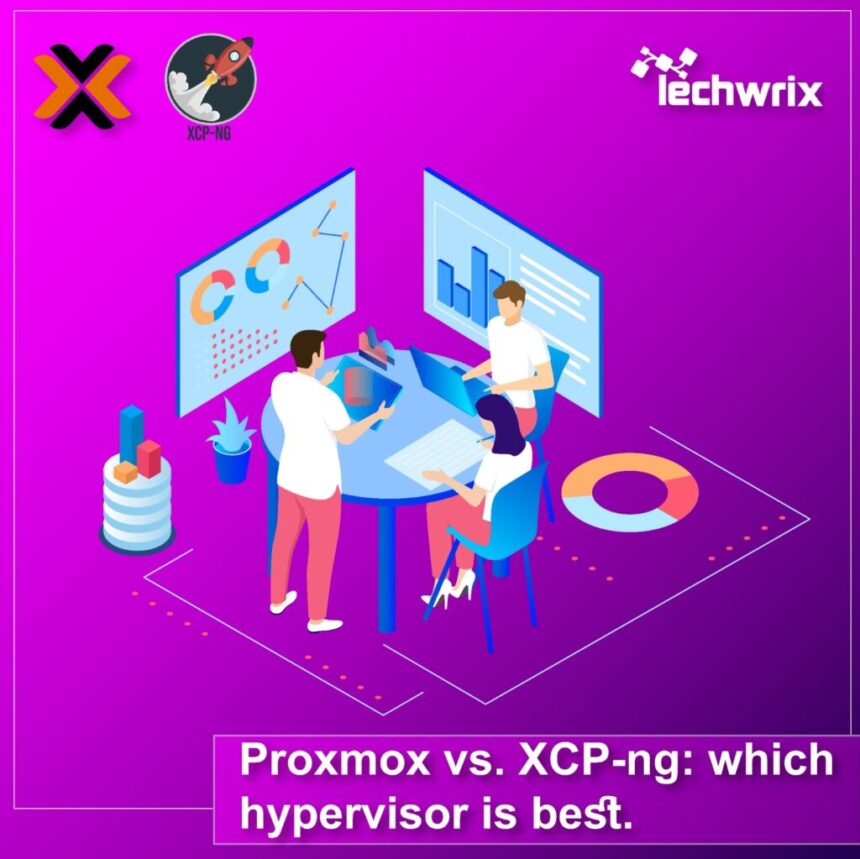The current Broadcom acquisition of VMware is creating uncertainty around the future of vSphere and other VMware products, with the latest change being the end of perpetual licenses. With such a key shift underway in the virtualization space, many businesses are exploring alternative solutions to VMware. Two prevalent open-source options that often emerge in this debate are XCP-ng and Proxmox.
In this article, we will explore the worlds of Proxmox and XCP-ng, comparing their features, performance, management capabilities, and open-source nature. By understanding each platform’s strengths and weaknesses, you will be able to make an informed choice about which virtualization platform best suits your networking needs.
So, let’s embark on this journey to find the ultimate winner in the Proxmox vs. XCP-ng battle! But first, we’ll look at exactly what XCP-ng and Proxmox are before comparing them.
Also Read: AWS vs Azure vs GCP: Which Cloud Platform Should You Learn?
Proxmox VE: A Popular Home Lab and SMB Choice
Let’s start with Proxmox, which is absolutely one of the most popular virtualization platforms for home lab and small office/home office (SOHO) users. Polls conducted on virtualization forums constantly show Proxmox topping the list for personal and non-professional use cases. There are worthy reasons for its popularity in these circles.
Key Features of Proxmox:
- Proxmox supports virtual machines (VMs) and containers, allowing you to run various operating systems simultaneously.
- Several Authentication Sources Proxmox VE has an integrated authentication server with numerous authentication sources, including the OpenID Connect authentication protocol, LDAP, Microsoft Active Directory, and Linux PAM.
- The storage options of the Proxmox virtual environment are very flexible. The web interface of Proxmox allows users to add multiple storage types, such as CephFS, GlusterFS, SMB/CIFS, iSCSI, and NFS shares (which can also be used for backing up VMs or Containers).
- IT Infrastructure Protection & Scheduled Backups with Proxmox VE using a built-in firewall.
- User-friendly web Interface makes creating, managing, and monitoring your virtualized environment easy.
- High Availability options, ensuring continuous uptime and minimizing downtime.
- Backup and restore options enable you to protect your data and applications.
- Granular Access & Collaboration with Ceph gives users access to and control over Ceph storage directly from their cluster nodes. Users can define granular access to all objects using Proxmox VE’s role-based permission management system.
Proxmox is a comprehensive virtualization platform that empowers organizations with the flexibility and scalability required for modern IT environments. With its powerful features and user-friendly interface, Proxmox is a popular choice for businesses of all sizes.
Also Read: Proxmox vs VMware ESXi: Which One Should You Choose?
XCP-ng: Stability, Scalability, and Support
XCP-ng is an open-source hypervisor that addresses some of Proxmox’s potential shortcomings for business use cases. It is a drop-in replacement for Citrix XenServer that maintains near feature parity while being fully open-source and non-proprietary.
Whether running a small business or managing a large-scale data center, XCP-ng offers the tools and capabilities to streamline operations and deliver optimal performance.

Key Features of XCP-ng:
- Multi-Server Management enables you to manage, monitor, and administer your data and infrastructure using a single agentless web interface.
- Live VM Migration allows you to migrate your virtual machines (VMs) live with little downtime.
- Live patching allows you to patch the XCP-hypervisor without suspending or shutting down VMs. You also aren’t forced to migrate your VMs from the host.
- Storage Migration lets you move your virtual disk within and across the resource pools. It also helps you adapt, maintain, and administer your storage and infrastructure without downtime.
- Accelerated Performance XCP-ng works with the Xen Orchestra Web UI and XCP-ng Center (Windows-based), allowing you to manage, monitor, and administer all your data and infrastructure from a single interface.
By leveraging XCP-ng, organizations can unlock the full potential of their infrastructure, harnessing virtualization to drive efficiency, scalability, and cost-effectiveness.
Pricing Plans: XCP-ng vs. Proxmox
The free version of Proxmox supports numerous features, but you must have a paid subscription to access technical support and enterprise repositories.
XCP-ng’s pricing plans don’t have feature restrictions or license fees. You only pay for support. Subscription costs are affordable even for medium-sized businesses. The open-source nature means self-support is always possible.

Key Factors to Consider
Flexibility
Proxmox provides a flexible and customizable Debian-based environment, perfect for experimenting and learning.
XCP-ng focuses more on stability and scalability out of the box.
Ease of Use
Proxmox’s GUI installer and streamlined interface simplify getting up and running quickly.
XCP-ng /ZO necessitates more initial configuration.
Scalability
XCP-ng has proved itself capable of massive deployments with thousands of VMs.
Proxmox’s abilities at gigantic scales remain relatively untested.
Support Options
Commercial 24/7 support is available for XCP-ng through Vates.
Proxmox only offers limited online community help during business hours.
Suitability
Proxmox is best for home labs, non-profits, and small businesses.
XCP-ng targets large, diverse enterprise deployments with round-the-clock operations.
Total Cost of Ownership
Proxmox remains free to use without limits. However, it offers paid plans with stable updates and limited support.
XCP-ng support subscriptions have become more worthwhile on larger scales.
For elastic tinkering, personal learning, or small deployments, Proxmox offers an outstanding free solution. However, businesses requiring serious scalability, high availability, and commercial support would be best served by XCP-ng, backed by the expertise of the Vates team. Both remain excellent options, depending on specific virtualization needs and priorities.
Also read: VMware Alternatives: Best Virtualization Solutions
Key Differences Between XCP-ng and Proxmox
The main difference between XCP-ng and Proxmox is that XCP-ng uses Xen Hypervisor and is built on CentOS, while Proxmox uses KVM and Debian GNU/Linux. These are substantial differences in user interaction, and the decision on which to use can, in some instances, solely be based on operating system comfort.
The chart below highlights key differences between XCP-ng vs. Proxmox.
| XCP-ng | PROXMOX | |
| Based On | Derived from XenServer, a commercial type-1 hypervisor product by Citrix. | Primarily a Xen-based type-1 hypervisor. Provisions for paravirtualization and full virtualization. |
| Virtualization Type | It supports local storage, NFS, iSCSI, and fiber channels. | Uses KVM and container-based virtualization with LXC. |
| Interface | Primarily managed via Xen Orchestra or CLI, but also has a basic GUI. | Provides a web-based GUI and CLI for management. |
| Backup | Provides a series of backup options via Xen Orchestra, including continuous replication. | Supports snapshot, backup, and live migration. |
| Storage | Supports local storage, NFS, iSCSI, and Fiber Channel. | Supports local storage, NFS, iSCSI, Ceph, and GlusterFS. |
| Networking | Provides network bonding, VLANs, and the option for software-defined networking with Open vSwitch. | Offers network bonding, VLANs, and software-defined networking with Open vSwitch. |
| High Availability | High availability can be achieved using clustering and pool features. | High availability is supported with Proxmox VE Cluster. |
| Community & Support | Open-source with active community support. Commercial support is available. | Open-source with a strong community. Commercial support is available. |
Conclusion
In conclusion, when comparing Proxmox VE and XCP-ng, it is important to consider each platform’s distinctive strengths and differences. Proxmox VE stands out for its user-friendly management interface, which makes it accessible for users of all skill levels. On the other hand, XCP-ng offers advanced features and scalability, making it suitable for complex environments.
When deciding between Proxmox VE and XCP-ng, specific needs, available resources, and personal preferences must be evaluated. Proxmox VE’s ease of use and intuitive interface make it ideal for those seeking simplicity and streamlined management. Conversely, if advanced features and scalability are of the utmost importance, XCP-ng may be the preferred option.
Thoroughly assess your virtualization requirements and conduct testing on both platforms to determine which one best meets your needs. Whether you prioritize user-friendliness or advanced features, Proxmox VE and XCP-ng offer robust virtualization solutions that enhance your infrastructure’s performance and efficiency.
Cheers for checking out the article on XCP-ng vs. Proxmox. If you have any questions, please leave them in the comments below!
FAQ’s
WHAT IS Proxmox VE?
Proxmox VE is a comprehensive open-source platform for enterprise virtualization that offers a web interface for easy management of virtual machines (VMs) and containers. It also provides tools for software-defined storage and networking, high-availability clustering, and more.
WHAT IS XCP-ng?
XCP NG is a turnkey open-source hypervisor built on the foundation of XenServer. It offers a feature-rich product without limitations and provides all its code on GitHub, allowing transparency and community contributions.
WHICH VIRTUALIZATION PLATFORM IS BETTER SUITED FOR MY NEEDS?
The choice between Proxmox VE and XCP NG depends on your needs, resources, and preferences. It is recommended that you assess your requirements and test both platforms to determine the best fit for your virtualization needs.
WHAT ARE THE SYSTEM REQUIREMENTS FOR RUNNING PROXMOX?
To run Proxmox, your system must have a 64-bit processor with virtualization extensions (Intel VT/AMD-V), a minimum of 4GB RAM, and sufficient storage space with a minimum of 32GB recommended.
SHOULD I CHOOSE SSD OR HDD FOR PROXMOX INSTALLATION?
The choice between SSD and HDD for Proxmox installation depends on your budget, performance, and storage requirements. SSDs offer quicker data access and improved system responsiveness, while HDDs are more affordable and provide larger storage capacities.

















